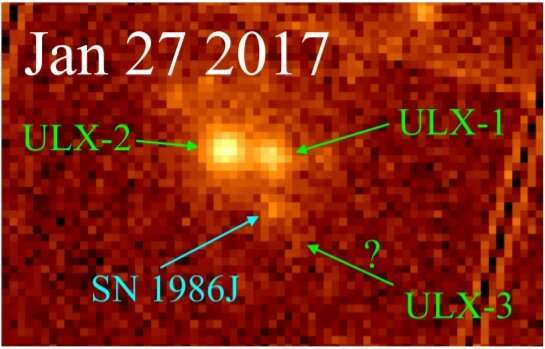December 30, 2021 report
Ultraluminous X-ray sources in NGC 891 investigated by researchers

Researchers from the University of Chicago and Fordham University have conducted a long-term monitoring of three ultraluminous X-ray sources (ULXs) in the spiral galaxy NGC 891. Results of the research, presented in a paper published December 22 on arXiv.org, provide more insights into the properties of these sources and could help us better understand the nature of the host galaxy.
ULXs are point sources in the sky that are so bright in X-rays that each emits more radiation than 1 million suns emit at all wavelengths. They are less luminous than active galactic nuclei (AGN), but more consistently luminous than any known stellar process. Although numerous studies of ULXs have been conducted, the basic nature of these sources still remains a puzzle.
Long-term monitoring using a wide range of spectral models is required in order to fully determine and understand the nature of ULXs. Now, a team of astronomers led by Nicholas M. Earley has analyzed the data collected from 2000 to 2017 with NASA's Chandra X-ray Observatory and ESA's XMM-Newton spacecraft. Combing through the datasets, they focused on the observations of NGC 891 (an edge-on, barred spiral galaxy about 30 million light years away) and its ultraluminous X-ray sources, designated ULX-1, ULX-2 and ULX-3.
"We perform empirical fits to the Chandra and XMM-Newton spectra of three ultraluminous X-ray sources in the edge-on spiral galaxy NGC 891, monitoring the region over a 17-year time window," the researchers wrote in the paper.
According to the study, ULX-1 shows some spectral evolution of this source from 2003 to 2016, and its light curve exhibits a possible slight decrease in flux over time, particularly from 2000 to 2003. However, the long-term stability of the light curve suggests that the source is not a highly variable object over these timescales. The luminosity of ULX-1 was measured to be about 8.4 duodecillion erg/s, while its column density was estimated to be around 8 sextillion cm-2.
ULX-2 has a remarkably constant flux that appears to be between 20 and 50 percent higher than that of ULX-1, which is expected from the count rates. The source has a column density of around 0.2 sextillion cm−2. with some variations. This value is lower than that found for ULX-1 by a factor of a few and turns out to be lower than any of the column densities calculated for the other known ULXs.
ULX-3 is the faintest of the three studied sources, with a luminosity at a level of 2 duodecillion erg/s, which places it in the lower luminosity range of detected ULXs. The derived column density was found to be approximately 2 sextillion cm-2. The research revealed that flux and column density around this source are both found to decrease by a factor of seven from November 2016 to January 2017. The astronomers added that at this time ULX-3 no longer qualifies as 'ultraluminous' as its lower luminosity value is more consistent with other high energy sources such as X-ray binaries.
More information: A Long-term Study of Ultraluminous X-ray Sources in NGC 891, arXiv:2112.12212 [astro-ph.HE] arxiv.org/abs/2112.12212
© 2021 Science X Network



















